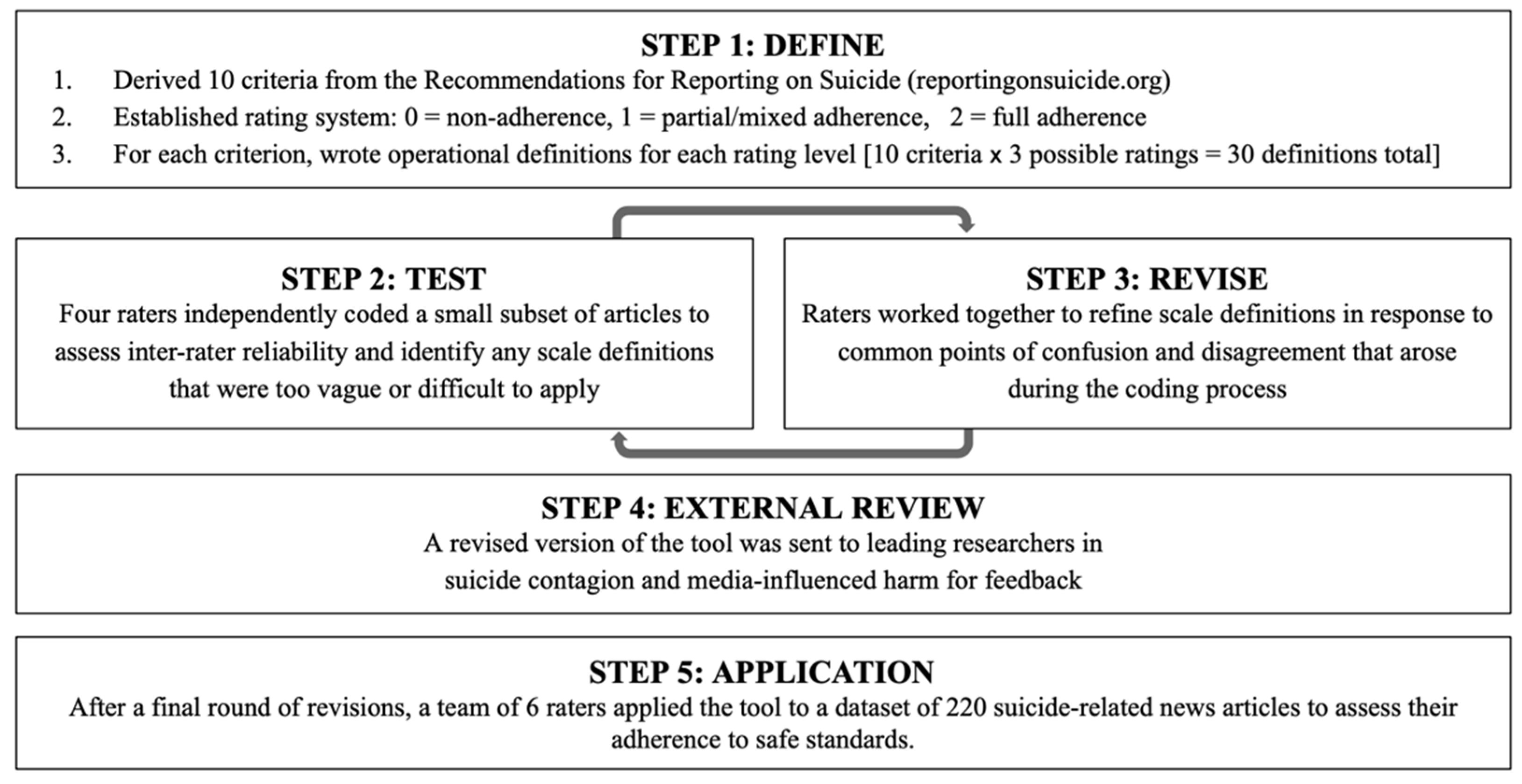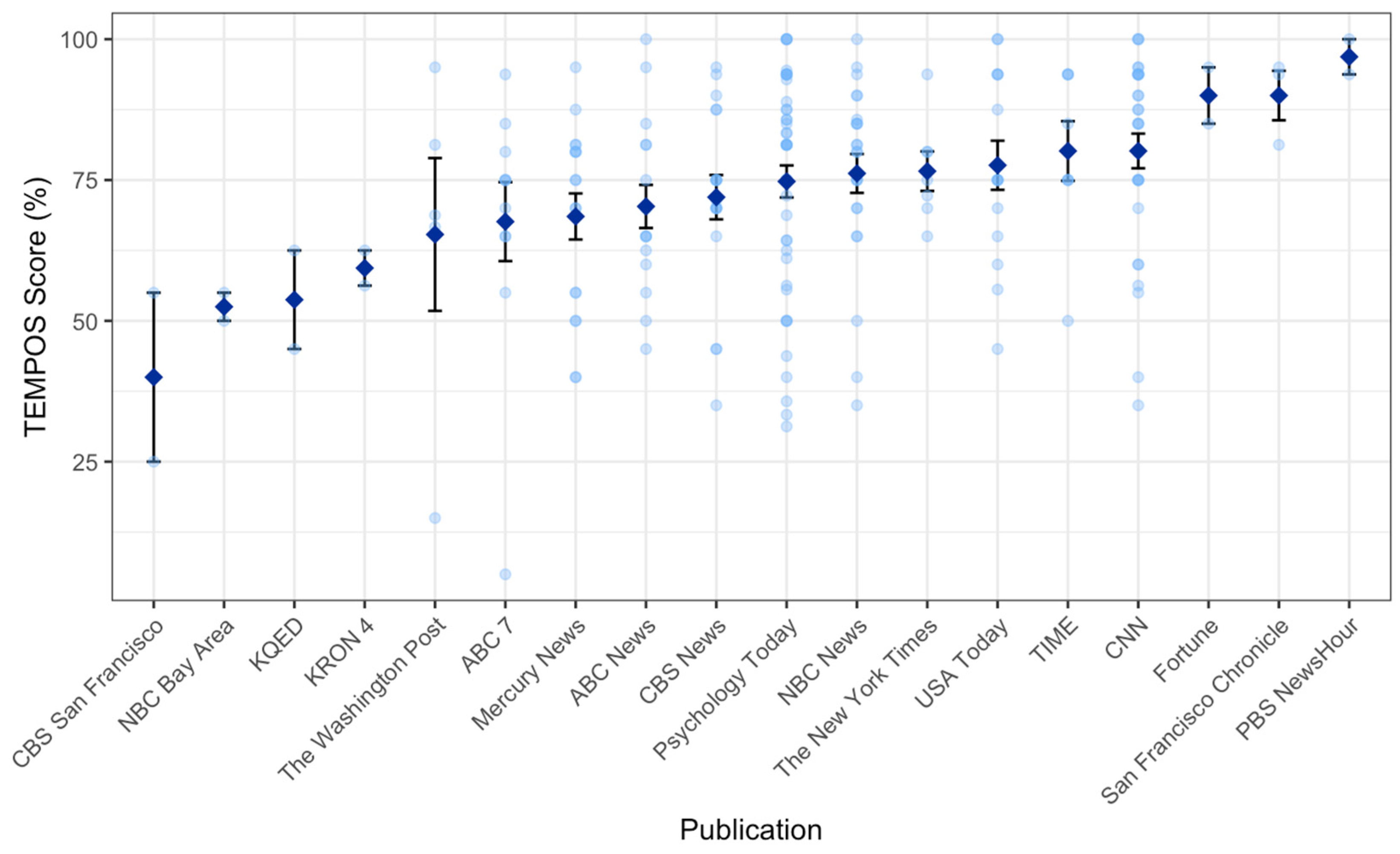The Tool for Evaluating Media Portrayals of Suicide (TEMPOS): Development and Application of a Novel Rating Scale to Reduce Suicide Contagion
Abstract
:1. Introduction
2. Materials and Methods
2.1. Scale Development
2.2. Suicide News Media Dataset
2.3. Application of Scale
3. Results
3.1. Characteristics of the Dataset
3.2. Inter-Rater Reliability
3.3. Analysis of TEMPOS Scores
4. Discussion
Limitations & Future Directions
5. Conclusions
Supplementary Materials
Author Contributions
Funding
Institutional Review Board Statement
Informed Consent Statement
Data Availability Statement
Acknowledgments
Conflicts of Interest
References
- World Health Organization. Suicide in the World: Global Health Estimates; World Health Organization: Geneva, Switzerland, 2019.
- Ostertag, L.; Golay, P.; Dorogi, Y.; Brovelli, S.; Bertran, M.; Cromec, I.; Vaeren, B.V.D.; Khan, R.; Costanza, A.; Wyss, K.; et al. The implementation and first insights of the french-speaking Swiss programme for monitoring self-harm. Swiss Med. Wkly. 2019, 149, w20016. [Google Scholar] [CrossRef] [Green Version]
- Griffin, E.; McMahon, E.; McNicholas, F.; Corcoran, P.; Perry, I.J.; Arensman, E. Increasing rates of self-harm among children, adolescents and young adults: A 10-year national registry study 2007–2016. Soc. Psychiatry Psychiatr. Epidemiol. 2018, 53, 663–671. [Google Scholar] [CrossRef] [PubMed]
- Twenge, J.M. Increases in depression, self-harm, and suicide among U.S. adolescents after 2012 and links to technology use: Possible mechanisms. Psychiatr. Res. Clin. Pract. 2020, 2, 19–25. [Google Scholar] [CrossRef] [Green Version]
- Biddle, L.; Derges, J.; Goldsmith, C.; Donovan, J.L.; Gunnell, D. Using the internet for suicide-related purposes: Contrasting findings from young people in the community and self-harm patients admitted to hospital. PLoS ONE 2018, 13, e0197712. [Google Scholar] [CrossRef] [PubMed]
- Arendt, F.; Scherr, S.; Romer, D. Effects of exposure to self-harm on social media: Evidence from a two-wave panel study among young adults. New Media Soc. 2019, 21, 2422–2442. [Google Scholar] [CrossRef] [Green Version]
- Phillips, D.P. The influence of suggestion on suicide: Substantive and theoretical implications of the werther effect. Am. Sociol. Rev. 1974, 39, 340–354. [Google Scholar] [CrossRef] [PubMed]
- Fu, K.-W.; Yip, P.S.F. Estimating the risk for suicide following the suicide deaths of 3 asian entertainment celebrities: A meta-analytic approach. J. Clin. Psychiatry 2009, 70, 869–878. [Google Scholar] [CrossRef] [PubMed]
- Niederkrotenthaler, T.; Fu, K.; Yip, P.S.F.; Fong, D.Y.T.; Stack, S.; Cheng, Q.; Pirkis, J. Changes in suicide rates following media reports on celebrity suicide: A meta-analysis. J. Epidemiol. Community Health 2012, 66, 1037–1042. [Google Scholar] [CrossRef] [PubMed]
- Pirkis, J.; Blood, R.W. Suicide and the media: Part I. reportage in nonfictional media. Crisis J. Crisis Interv. Suicide Prev. 2001, 22, 146–154. [Google Scholar] [CrossRef] [PubMed]
- Sisask, M.; Varnik, A. Media roles in suicide prevention: A systematic review. Int. J. Environ. Res. Public Health 2012, 9, 123–138. [Google Scholar] [CrossRef] [PubMed] [Green Version]
- Stack, S. Media impacts on suicide: A quantitative review of 293 findings. Soc. Sci. Q. 2000, 81, 957–971. [Google Scholar]
- Gould, M.S.; Kleinman, M.H.; Lake, A.M.; Forman, J.; Midle, J.B. Newspaper coverage of suicide and initiation of suicide clusters in teenagers in the USA, 1988–1996: A retrospective, population-based, case-control study. Lancet Psychiatry 2014, 1, 34–43. [Google Scholar] [CrossRef]
- Cheng, A.T.A.; Hawton, K.; Chen, T.H.H.; Yen, A.M.F.; Chang, J.-C.; Chong, M.-Y.; Liu, C.-Y.; Lee, Y.; Teng, P.-R.; Chen, L.-C. The influence of media reporting of a celebrity suicide on suicidal behavior in patients with a history of depressive disorder. J. Affect. Disord. 2007, 103, 69–75. [Google Scholar] [CrossRef] [PubMed]
- Zahl, D.L.; Hawton, K. Media influences on suicidal behaviour: An interview study of young people. Behav. Cogn. Psychother. 2004, 32, 189–198. [Google Scholar] [CrossRef] [Green Version]
- Gould, M.; Jamieson, P.; Romer, D. Media contagion and suicide among the young. Am. Behav. Sci. 2003, 46, 1269–1284. [Google Scholar] [CrossRef] [Green Version]
- Lee, J.; Lee, W.-Y.; Hwang, J.-S.; Stack, S.J. To what extent does the reporting behavior of the media regarding a celebrity suicide influence subsequent suicides in South Korea? Suicide Life-Threat. Behav. 2014, 44, 457–472. [Google Scholar] [CrossRef] [PubMed]
- Sinyor, M.; Schaffer, A.; Nishikawa, Y.; Redelmeier, D.A.; Niederkrotenthaler, T.; Sareen, J.; Levitt, A.J.; Kiss, A.; Pirkis, J. The association between suicide deaths and putatively harmful and protective factors in media reports. CMAJ 2018, 190, E900–E907. [Google Scholar] [CrossRef] [PubMed] [Green Version]
- Whitley, R.; Fink, D.S.; Santaella-Tenorio, J.; Keyes, K.M. Suicide mortality in Canada after the death of robin williams, in the context of high-fidelity to suicide reporting guidelines in the Canadian media. Can. J. Psychiatry 2019, 64, 805–812. [Google Scholar] [CrossRef] [PubMed]
- Niederkrotenthaler, T.; Voracek, M.; Herberth, A.; Till, B.; Strauss, M.; Etzersdorfer, E.; Eisenwort, B.; Sonneck, G. Role of media reports in completed and prevented suicide: Werther v. papageno effects. Br. J. Psychiatry 2010, 197, 234–243. [Google Scholar] [CrossRef] [Green Version]
- Etzersdorfer, E.; Sonneck, G. Preventing suicide by influencing mass-media reporting. the viennese experience 1980–1996. Arch. Suicide Res. 1998, 4, 67–74. [Google Scholar] [CrossRef]
- Niederkrotenthaler, T. A Suicide-protective papageno effect of media portrayals of coping with suicidality. Inj. Prev. 2016, 22, A8–A9. [Google Scholar] [CrossRef] [Green Version]
- World Health Organization; International Association for Suicide Prevention. Preventing Suicide: A Resource for Media Professionals, 2017 Update; World Health Organization: Geneva, Switzerland, 2017.
- SAVE Reporting on Suicide. Available online: https://reportingonsuicide.org/ (accessed on 4 January 2022).
- Canadian Journalism Forum on Violence and Trauma Mindset: Reporting on Mental Health. Available online: https://www.mindset-mediaguide.ca (accessed on 25 January 2022).
- Hunter Institute of Mental Health. Reporting Suicide and Mental Illness: A Mindframe Resource for Media Professionals; Hunter Institute of Mental Health: Newcastle, Australia, 2014. [Google Scholar]
- Niederkrotenthaler, T.; Sonneck, G. Assessing the impact of media guidelines for reporting on suicides in Austria: Interrupted time series analysis. Aust. N. Z. J. Psychiatry 2007, 41, 419–428. [Google Scholar] [CrossRef] [PubMed]
- Barker, E.; Kolves, K.; Leo, D.D. Rail-suicide prevention: Systematic literature review of evidence-based activities. Asia Pac. Psychiatry 2017, 9, e12246. [Google Scholar] [CrossRef] [PubMed]
- Creed, M.; Whitley, R. Assessing fidelity to suicide reporting guidelines in Canadian news media: The death of robin williams. Can. J. Psychiatry 2017, 62, 313–317. [Google Scholar] [CrossRef]
- McTernan, N.; Spillane, A.; Cully, G.; Cusack, E.; O’Reilly, T.; Arensman, E. Media reporting of suicide and adherence to media guidelines. Int. J. Soc. Psychiatry 2018, 64, 536–544. [Google Scholar] [CrossRef]
- Pirkis, J.; Dare, A.; Blood, R.W.; Rankin, B.; Williamson, M.; Burgess, P.; Jolley, D. Changes in media reporting of suicide in Australia between 2000/01 and 2006/07. Crisis 2009, 30, 25–33. [Google Scholar] [CrossRef]
- Gould, M.; Midle, J.B.; Insel, B.; Kleinman, M. Suicide reporting content analysis: Abstract development and reliability. Crisis 2007, 28, 165–174. [Google Scholar] [CrossRef] [PubMed]
- Pitman, A.; Stevenson, F. Suicide reporting within British newspapers’ arts coverage: Content analysis of adherence to media guidelines. Crisis J. Crisis Interv. Suicide Prev. 2015, 36, 13–20. [Google Scholar] [CrossRef] [PubMed]
- Nutt, R.; Kidd, B.; Matthews, K. Assessing the adherence to guidelines of media reporting of suicide using a novel instrument--the “Risk of imitative suicide scale” (RISc). Suicide Life-Threat. Behav. 2015, 45, 360–375. [Google Scholar] [CrossRef] [PubMed]
- Sumner, S.A.; Burke, M.; Kooti, F. Adherence to suicide reporting guidelines by news shared on a social networking platform. Proc. Natl. Acad. Sci. USA 2020, 117, 16267–16272. [Google Scholar] [CrossRef]
- Garcia-Williams, A.; O’Donnell, J.; Spies, E.; Zhang, X.; Young, R.; Azofeifa, A.; Vagi, K. Epi-Aid 2016–018: Undetermined Risk Factors for Suicide Among Youth, Ages 10–24—Santa Clara County, CA, 2016; Centers for Disease Control and Prevention: Atlanta, GA, USA, 2017. [Google Scholar]
- McHugh, M.L. Interrater reliability: The kappa statistic. Biochem. Med. 2012, 22, 276–282. [Google Scholar] [CrossRef]
- Sheftall, A.H.; Tissue, J.L.; Schlagbaum, P.; Singer, J.B.; Young, N.; Stevens, J.H.; Ackerman, J.P. Newspaper adherence to media reporting guidelines for the suicide deaths of kate spade and anthony bourdain. JAMA Netw. Open 2019, 2, e1914517. [Google Scholar] [CrossRef] [PubMed]
- Shearer, E.; Mitchell, A. News use across social media platforms in 2020. Pew Res. Cent. J. Proj. 2021. Available online: https://www.journalism.org/wp-content/uploads/sites/8/2021/01/PJ_2021.01.12_News-and-Social-Media_FINAL.pdf (accessed on 28 January 2022).
- Luxton, D.D.; June, J.D.; Fairall, J.M. Social media and suicide: A public health perspective. Am. J. Public Health 2012, 102, S195–S200. [Google Scholar] [CrossRef] [PubMed]
- Robinson, J.; Hill, N.T.M.; Thorn, P.; Battersby, R.; Teh, Z.; Reavley, N.J.; Pirkis, J.; Lamblin, M.; Rice, S.; Skehan, J. The #chatsafe project. developing guidelines to help young people communicate safely about suicide on social media: A delphi study. PLoS ONE 2018, 13, e0206584. [Google Scholar] [CrossRef] [Green Version]
- Pennebaker, J.W.; Francis, M.E.; Booth, R.J. Linguistic inquiry and word count: LIWC 2001. Mahway Lawrence Erlbaum Assoc. 2001, 71, 2001. [Google Scholar]






| # | Criterion Name |
|---|---|
| 1 | Framing of Suicide |
| 2 | Factual & Non-Speculative Information |
| 3 | Appropriate/Non-Stigmatizing Language |
| 4 | Details About Suicide Method/Scene |
| 5 | Details About Suicide Note |
| 6 | Visual Content |
| 7 | Reasons & Risk Factors for Suicide |
| 8 | Sensational Language |
| 9 | Glamorization of Suicide |
| 10 | Suicide Prevention/Mental Health Resources |
| Characteristic | n (%) | |
|---|---|---|
| Section | ||
| News | 89 (40.5%) | |
| Blog | 46 (20.9%) | |
| Health | 28 (12.7%) | |
| Entertainment | 24 (10.9%) | |
| Other | 24 (10.9%) | |
| Opinion | 5 (2.27%) | |
| Sports | 4 (1.82%) | |
| Region | ||
| National (USA) | 178 (80.9%) | |
| Local (SF Bay Area) | 42 (19.1%) | |
| Publication Type | ||
| Broadcast News Company | 115 (52.3%) | |
| Magazine | 60 (27.3%) | |
| Newspaper | 51 (23.2%) | |
| Criterion | % Pure Agreement | κ (Linear Weights) |
|---|---|---|
| Framing of Suicide | 73.64% | 0.513 |
| Factual & Non-Speculative Information | 68.18% | 0.452 |
| Appropriate/Non-Stigmatizing Language | 83.10% | 0.587 |
| Details About Suicide Method/Scene | 91.82% | 0.941 |
| Details About Suicide Note | 97.27% | 0.975 |
| Visual Content | 92.27% | 0.832 |
| Reasons & Risk Factors for Suicide | 76.82% | 0.569 |
| Sensational Language | 73.18% | 0.378 |
| Glamorization of Suicide | 75.90% | 0.173 |
| Suicide Prevention/Mental Health Resources | 80.90% | 0.743 |
| AVERAGE | 81.31% | 0.616 |
Publisher’s Note: MDPI stays neutral with regard to jurisdictional claims in published maps and institutional affiliations. |
© 2022 by the authors. Licensee MDPI, Basel, Switzerland. This article is an open access article distributed under the terms and conditions of the Creative Commons Attribution (CC BY) license (https://creativecommons.org/licenses/by/4.0/).
Share and Cite
Sorensen, C.C.; Lien, M.; Harrison, V.; Donoghue, J.J.; Kapur, J.S.; Kim, S.H.; Tran, N.T.; Joshi, S.V.; Patel, S.G. The Tool for Evaluating Media Portrayals of Suicide (TEMPOS): Development and Application of a Novel Rating Scale to Reduce Suicide Contagion. Int. J. Environ. Res. Public Health 2022, 19, 2994. https://doi.org/10.3390/ijerph19052994
Sorensen CC, Lien M, Harrison V, Donoghue JJ, Kapur JS, Kim SH, Tran NT, Joshi SV, Patel SG. The Tool for Evaluating Media Portrayals of Suicide (TEMPOS): Development and Application of a Novel Rating Scale to Reduce Suicide Contagion. International Journal of Environmental Research and Public Health. 2022; 19(5):2994. https://doi.org/10.3390/ijerph19052994
Chicago/Turabian StyleSorensen, Chloe Chang, Mego Lien, Vicki Harrison, John J. Donoghue, Jeevanjot Singh Kapur, Song Hi Kim, Nhi Thi Tran, Shashank V. Joshi, and Sita G. Patel. 2022. "The Tool for Evaluating Media Portrayals of Suicide (TEMPOS): Development and Application of a Novel Rating Scale to Reduce Suicide Contagion" International Journal of Environmental Research and Public Health 19, no. 5: 2994. https://doi.org/10.3390/ijerph19052994







